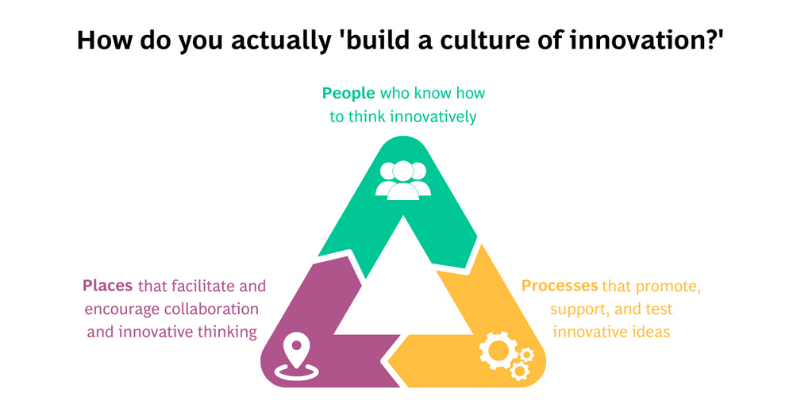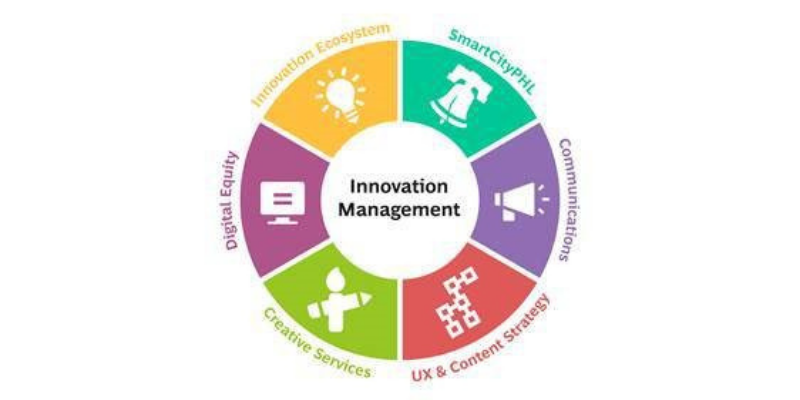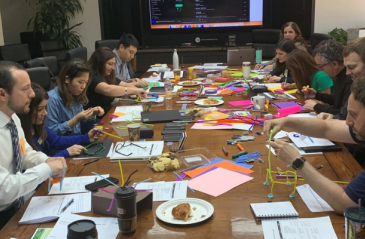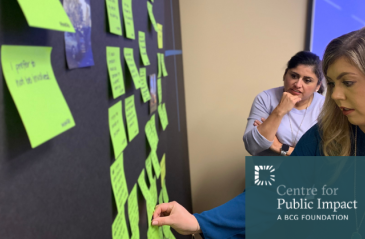
West Philadelphia Skills Initiative Generates $37 Million in Wages from Previously Excluded Workers


"Creating an innovation ecosystem inside govt required many skills we used for previous work - strong program management, ability to think strategically, patience for collaboration, and curiosity to overcome discomfort associated with trying new things."
Share articleHow do you build a culture of innovation? Andrew Buss & @elizaPHL from @PHLinnovation framed their work around the three pillars of People, Place, and Process
Share article"Establishing an innovation team within the technology office increases continuity as elected officials change, and gives the team insight into the city’s business transformation challenges." @Wheelmrk
Share articleWe put our vision for government into practice through learning partner projects that align with our values and help reimagine government so that it works for everyone.
We don’t often talk about recycling employees in government, and perhaps re-inventing employees sounds better. Regardless of word choice, however, identifying well-suited existing employees and giving them a new mission can prove an effective way to establish a municipal innovation team. Philadelphia’s first municipal innovation team formed nearly a decade ago with the right mix of people that were ready to try something new.
In 2012, I (Andrew) and another colleague in the Office of Innovation & Technology were just finishing the implementation of a large federal grant for public computer centers. At the same time, we had a new Chief Information Officer who one day told us that he wanted to make government more innovative – a small and definitely achievable goal, right? Although my colleague and I believed that our design and implementation of our public technology program was certainly creative, neither of us had specifically focused on the concept of innovation in a government context before. And we were still ‘out-of-the-box’ employees in a technology office that had only begun doing public-facing technology work during our public computer center grant.
It turned out that creating an innovation ecosystem inside government required many of the same skill sets we had used for our previous work - strong program management, an ability to think strategically, patience for collaboration, and curiosity to overcome any discomfort associated with trying new things in a risk adverse environment. It’s not a particularly glamorous origin story, but at that point the two of us become the Philadelphia innovation team, formally named the Innovation Management Team. A year later, my colleague would move on to a leadership role in government just as Eliza joined us to continue developing our innovation work.
Innovation in government means a lot of things to different people. Our approach was to frame our work around the three pillars of People, Place, and Process – train employees in the principles of innovation, provide them a space conducive to collaboration, and provide a framework through which to apply the principles of innovation and test new ideas. Our first three initiatives – the Innovation Academy, Lab, and Fund – formed the core of a portfolio that has subsequently grown and taken on many facets just as the innovation team itself has grown.
Innovation in government means a lot of things to different people. Our approach was to frame our work around the three pillars of People, Place, and Process.

It’s also worth noting that the way our team was created, the mission behind our work, and the eventual evolution of our portfolio all look very different from innovation models in other cities. Not only were we fully staffed and funded by internal people and resources right from the start, but we chose to intentionally focus on the human and capacity side, not the specific “problem solving” side, of innovation. Instead of tackling unique City challenges ourselves, like finding a creative way to fill dangerous potholes more efficiently or improve residents’ feelings about trash pickup, we chose, and still choose every day, to build an ecosystem where employees in the Streets Department can identify, ideate around, and solve those problems themselves though the programs we offer. Our approach has truly been to democratize innovation so that this work feels accessible and relevant to any and all employees, not just those of us with “innovation” in our titles.
Just two years after the Innovation Management team was established, Philadelphia went through a mayoral transition. We found ourselves not only needing to think strategically about our core work, which was still new, but about how we could weather the changes that come with a new administration and executive team.
In many cities, the innovation function sits directly in the Mayor’s Office, which no doubt has its own set of benefits – the cache that comes with residing in the “most important” office in government, access to City leadership, and an ability to work on and impact citywide, high-level priorities. But being a Mayor’s Office initiative also presents its own set of dangers – namely the tenuous position people and programs face during a mayoral transition, making it exceedingly challenging to sustain the work beyond the four or eight years of a mayor’s term.
In Philadelphia, however, the Innovation team was, and still is, housed in OIT, a more traditional operating department, which afforded us a certain level of “protection” during the administration change. We knew we would have to contend with a new Chief Information Officer, but we had an overall higher level of confidence that if we thoughtfully approached the months leading up to the election, our jobs and our portfolio could survive. Our approach was three pronged:
First, we leveraged our network of supporters across government and intentionally had them champion us in conversations and future planning. These advocates helped both outgoing and incoming leadership teams better understand our work and value and helped make the case that the new Mayor should keep us on board.
Second, we were realistic about the fact that not everyone “gets” innovation, and our time and energy was better spent engaging with our allies and potential allies than trying to convince the skeptics. We became adept at shaping our messages and value add based on our audience and that kind of specific, tailored engagement paid off (spoiler alert, we survived that first mayoral transition).
Third, we knew that anyone brought in as part of the new administration would have their own vision for the innovation work, and we were open – and eager – to integrate that new vision with our original portfolio. Most notably, our work became a bit more internally focused; we began to think more about how our initiatives could directly impact the work and goals of OIT – another facet of living in an operational department.
After the new administration was in place, the innovation portfolio really evolved. We had two years of success behind us and knew we had at least four more ahead before we would face another election cycle. Professionally, Andrew and I (Eliza) both moved into elevated roles – Andrew’s Deputy CIO scope grew to incorporate more department-wide strategy and policy, and I officially took on the title of Director of Innovation. In our new(ish) roles, we both had the autonomy to reimagine and further develop elements of our original work, as well as launching new, complementary initiatives to our core People, Place, Process model.
We first spent time evaluating the Innovation Academy and Fund, two of our flagship programs. The Academy was becoming increasingly popular and competitive, and we made the application process more robust to make sure we were selecting employees who would truly be the best fit for the program. We developed new curriculum modules based on feedback and lessons learned from earlier cohorts, and added content related to facilitation, public speaking, and stakeholder engagement. Perhaps most impactful, we hosted the City’s first Innovation Expo and invited Academy graduates to share success stories and lessons learned with current students and City leadership, all of which helped prove the point that the program was truly having a positive impact on government programs, policies, and culture.
The Innovation Fund went through a similar “growth spurt” as we further developed infrastructure and governance surrounding our granting process. We evaluated the roles and responsibilities of the employees on the Innovation Advisory Group and worked hard to ensure that body was truly reflective of City government. We built in more extensive data and evaluation methods to show the value of our pilot investments, and we collaborated more closely with the Mayor’s Fund for Philadelphia, our fiscal partner, to help make the case that we should do two grant cycles, not one, per year. We also leveraged the Innovation Fund process to help the City navigate other large-scale ideation and application opportunities, like the Bloomberg Mayor’s Challenge – proving the true value of our work was not the granting per se, but the ability to help government source and refine ideas to become the best, most innovative version possible.
The workshops are developed around human-centered design thinking tools and techniques and leverage the experience and knowledge of participants to generate new ideas and begin to develop their own solutions.
Perhaps most unique, however, was the creation of Innovation Consulting, a new initiative that allows us to truly offer “innovation as a service,” both internal and external to government. Consulting seeks to explain how some of our strategies and techniques can be applied for a variety of professional environments and challenges, and why it’s important that innovation – with its myriad definitions and interpretations – be strategically and intentionally incorporated into employees’ portfolios. The core service of Innovation Consulting involves planning and facilitating targeted and individualized workshops for teams and organizations who face operational challenges ranging from stakeholder communication to process improvement to program evaluation. The workshops are developed around human-centered design thinking tools and techniques and leverage the experience and knowledge of participants to generate new ideas and begin to develop their own solutions.
It seems par for the course that most, if not all, municipal innovation teams have to pivot their core work to some degree, and at some point, to meet the needs of new mayoral or departmental leadership. New leaders have different interests, and innovation teams find a way to adapt their work to fit those interests. Fortunately, the employee skillsets of an innovation team are conducive to taking on new responsibilities and often make the team a logical place to add functions and initiatives that don’t fit neatly into a department’s traditional mission.
Our location within the City’s technology office meant that we typically took on initiatives not traditionally considered part of a technology organization’s strategy. And although our core work of building an innovation ecosystem continued during and after our last mayoral transition in 2016, we also assumed other responsibilities for the technology office and City. Complementing our digital equity work, which had always remained part of our portfolio, the City’s interest in its existing wireless assets soon led to the development of a Smart City initiative tasked with redefining the concept of a Smart City and making it relevant for the broader public. Once again, an existing member of the innovation team would expand her role and launch that initiative – mostly because we were, and remain, the team that takes on new and potentially “random” projects, all in the name of adaptation and innovation.
Soon after, the innovation team added other members. First, a communications role was created to publicize the City’s growing number of public technology initiatives while also improving our ability as an organization to provide clear messaging to other departments about critical technology matters. Next, our team took on an existing group in Creative Services as well as web teams focusing on User Experience (U/X) design and Content Management. And in 2020, the COVID-19 pandemic raised the issue of digital equity to new prominence with the sudden demands for remote work, school, and health care. As a result, we quickly expanded our digital equity role and now have two full-time employees focusing on applying innovation to the digital divide challenge.

Despite successfully growing our team and expanding the work, our presence in the City’s technology office can yield contradictory feelings: sometimes we feel like we belong because we do things unique to the City and often focus on resident-facing technology. At other times it’s apparent that we do very different work from our other colleagues in the office and do not talk about technology in the same way. Our location in the technology office leads many to assume that our innovation is driven entirely by technology – instead, we focus first on processes and programs before considering how technology might enable them.
As our current Chief Information Officer Mark Wheeler notes:
“For a city’s innovation program to truly take root, it needs to survive changes within and between mayoral administrations. Establishing an innovation team within the technology office increases continuity as elected officials change, and also gives the team insight into the city’s business transformation challenges when other departments make a project or procurement request. With this visibility, we have opportunities to engage with departments early to build their capacity for problem-solving and decision-making that drive significant outcomes.”
Just as our team’s work has evolved and expanded over the past eight years, so has the role of technology offices in cities. These departments are now expected to serve myriad functions – not only ensuring that all government offices can rely on secure, well-functioning networks and business applications, but also figuring out how to drive innovation and provide meaningful technology interactions and services for residents. Philadelphia recognized earlier on than most that there should, and can be, a symbiotic relationship between all these goals, and we truly believe that the creation of our innovation team contributed immensely to the success of OIT’s more core and “traditional” services.
It’s also our hope that our story inspires other cities to think about their own capacity to launch (and sustain!) innovation programs, especially within their existing structure and capacities. Creating this kind of portfolio doesn’t necessarily require new staff, large budgets and shiny technology – as we’ve learned, there is so much that can be accomplished by “just” repurposing current employees and being open to hearing new ideas and methods of problem solving. When we reflect on where we started and how far we’ve come, we realize that we owe our success primarily to our ability to build cross-departmental coalitions, to respond to the changing needs and priorities of leadership, and to constantly evaluate our role within our department, and our department’s role within government – and those are things that any, and maybe even every, city can aspire to achieve.
We put our vision for government into practice through learning partner projects that align with our values and help reimagine government so that it works for everyone.





